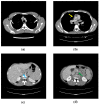Activated Phosphoinositide 3-Kinase Delta Syndrome 1: Clinical and Immunological Data from an Italian Cohort of Patients
- PMID: 33080915
- PMCID: PMC7603210
- DOI: 10.3390/jcm9103335
Activated Phosphoinositide 3-Kinase Delta Syndrome 1: Clinical and Immunological Data from an Italian Cohort of Patients
Abstract
Activated phosphoinositide 3-kinase delta syndrome 1 (APDS-1) is a recently described inborn error of immunity caused by monoallelic gain-of-function mutations in the PIK3CD gene. We reviewed for the first time medical records and laboratory data of eight Italian APDS-1 patients. Recurrent sinopulmonary infections were the most common clinical feature at onset of disease. Seven patients presented lymphoproliferative disease, at onset or during follow-up, one of which resembled hemophagocytic lymphohistiocytosis (HLH). Genetic analysis of the PIK3CD gene revealed three novel mutations: functional testing confirmed their activating nature. In the remaining patients, the previously reported variants p.E1021K (n = 4) and p.E525A (n = 1) were identified. Six patients were started on immunoglobulin replacement treatment (IgRT). One patient successfully underwent hematopoietic stem cell transplantation (HSCT), with good chimerism and no GVHD at 21 months post-HSCT. APDS-1 is a combined immune deficiency with a wide variety of clinical manifestations and a complex immunological presentation. Besides IgRT, specific therapies targeting the PI3Kδ pathway will most likely become a valid aid for the amelioration of patients' clinical management and their quality of life.
Keywords: PI3K; PIK3CD; activated phosphoinositide 3-kinase delta syndrome 1; lymphoproliferation; p110δ; primary combined immune deficiency.
Conflict of interest statement
The authors declare no conflict of interest.
Figures



References
-
- Lucas C.L., Kuehn H.S., Zhao F., Niemela J.E., Deenick E.K., Palendira U., Avery D.T., Moens L., Cannons J.L., Biancalana M., et al. Dominant-activating germline mutations in the gene encoding the PI(3)K catalytic subunit p110δ result in T cell senescence and human immunodeficiency. Nat. Immunol. 2014;15:88–97. doi: 10.1038/ni.2771. - DOI - PMC - PubMed
Grants and funding
LinkOut - more resources
Full Text Sources
Miscellaneous

